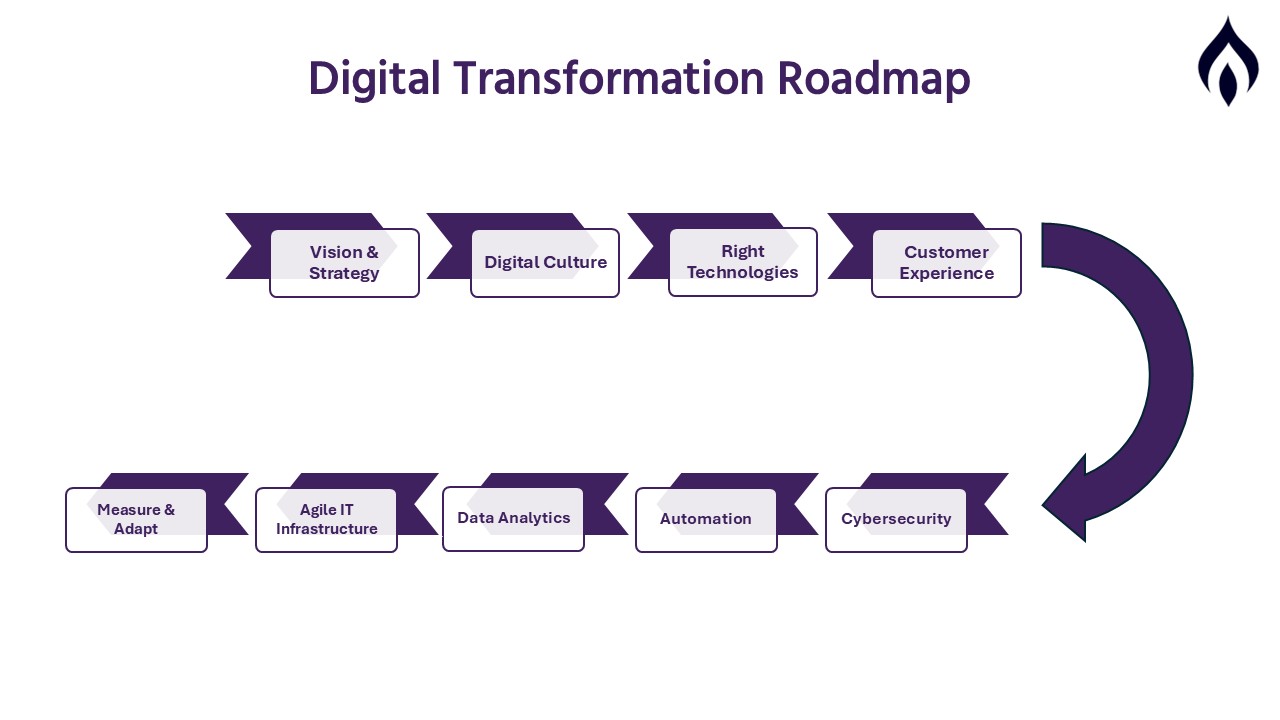
A Digital Transformation roadmap for Billion Dollar Organizations
A Digital Transformation roadmap for Billion Dollar Organizations
Introduction:
The digital transformation cannot be viewed only through the lens of new technology, since it represents a whole paradigm shift in culture, operations, and customer engagement. The right roadmap can help large organizations traverse through this complicated journey toward meeting the test and a future expanded in innovation sustained and constantly finding ways for growth.
Understanding Digital Transformation
Digital transformation is the strategic use of digital technologies to improve processes and customer experiences and drive business innovation. Digital technologies such as AI, cloud computing, big data analytics, IoT, and automation are leveraged to redefine the business model and operations.
The Need for Digital Transformation in Large Organizations
For large companies, it seems that digital transformation cannot be simply regarded as an option anymore; it is becoming a necessity. The major forces driving the change include:
- Changing Customer Expectations-Consumers expect seamless digital interfaces, personalization, and instant access to products and services.
- Competitive Pressure-Startups and flexible competitors are using digital tools to disrupt commerce, forcing established companies into innovation.
- Operational Efficiency-Digital transformation helps reduce costs and improve productivity through automation.
- Data-Driven Decision Making-Advanced analytics and AI enable organizations to derive valuable insight and make informed decisions.
A Roadmap for Digital Transformation
- Establish a Clear Vision and Strategy
Before a digital transformation can be undertaken, the organization should have a clear vision that should align with the business objectives. Indeed, this is essential for success. The visionary goals for the project would better allow any action that is needed in their organizational plan to follow some common theme that has been aptly articulated and carved out by the leadership. The roadmap to get there would thus depict:
- Short and long-term goals.
- Key performance indicators (KPIs) that the organizations shall use to measure success.
- Areas that require digital intervention.
- Nurturing a Digital-First Culture
The success of the digital transformation depends on a cultural shift. Employees need
to be encouraged to embrace innovation, agility, and relentless learning. Steps to create a culture of digital first include:
- An upskilling program for members in emerging technology.
- Pushing towards collaboration between IT and business units.
- Promoting a culture of experimentation for innovation.
- Invest in the Right Technologies
The choice of technologies for digital pivoting is crucial in the transformation. The key technologies to think about include:
- Cloud computing—scalability in operations
- AI and machine learning—enhanced decision-making, and automation
- Big data and analytics—customer engagement and business strategies
- IOT and automation—process streamlining leading to operational efficiency
- Improve the Customer Experience
Customer experience (CX) should be at the core of digital transformation. Organizations must utilize digital channels, personalization, and omnichannel schemes to boost engagement. Best practices include implementing an AI-powered chatbot for customer support, providing a seamless omnichannel experience, and using customer data to provide personalized services.
- Strengthen Cybersecurity and Compliance
With digital transformation comes the issue of cybersecurity threats and regulatory compliance. Large enterprises must implement a strong security framework to protect sensitive data, which includes:
- Adoption of advanced cybersecurity protocols.
- Enforcement of compliance with global data protection regulations, e.g. GDPR, CCPA.
- Ensuring regular security audits.
- Optimize Business Operations Through Automation
Automation plays a vital role in improving operational efficiency. Organizations need to turn to automation to free human capital for strategic roles. Automation includes:
- Robotic process automation for back-office work.
- AI-driven supply chain optimization.
- Predictive maintenance within manufacturing.
- Leverage Data Analytics for Decision Making
Billion-dollar organizations generate massive amounts of data. Using data analytics could give insights that can drive growth for a business. Infected
- Implement real-time analytics for better decision-making.
- Utilize AI-driven predictive analytics for trend forecasting.
- Leverage client analytics for precision marketing.
- Establishing Agile and Scalable IT Infrastructure
A scalable and agile IT infrastructure forms the backbone of a digital transformation. Enterprises must:
- Migrate to cloud-based solutions.
- Adopt microservices architecture for scalability with flexibility within environments.
- Introduce DevOps practices for quicker software releases.
- Measure and Adapt
Digital transformation is a work in progress that must be innovated continuously and nevertheless will be open for iterations. Organizations must:
- Regularly monitor the KPIs and performance metrics.
- Engage employees and customers for feedback.
- Adapt flexibly and introduce iterative enhancements.
Challenges in Digital Transformation and How to Overcome Them
Despite being advantageous, digital transformation has its disadvantages as well.
- Resistance to Change: Employees and stakeholders may refuse to embrace the advances brought about by digital transformation; implement change management programs and training.
- High Initial Investment: Digital transformation, however, requires a hefty capital outlay; by the nature of the expenditures, set priorities on initiatives based on an expected ROI and consider phasing the implementation.
- Data Privacy Concerns: Managing large-lifetime data will pose security threats. Adopt a strict code of data governance on top of enhanced security measures.
Conclusion:
Digital transformation for billion-dollar companies is the biggest transformation because of its many benefits, which include improved efficiencies, protection of customers’ experiences, and competitive benefits. Nevertheless, achieve transformation only with a thought-out roadmap, make strategic investments, and build a climate conducive to innovation. Large enterprises can deal with that digital shift effectively while ensuring sustained success in a highly digital space through such measures detailed above.

Add a review
Your email address will not be published. Required fields are marked *